Click here for HYDROTHERMAL VENTS
| METHANE and other COLD
SEEPS Click here for HYDROTHERMAL VENTS |
Return to my MAIN DEEP-SEA PAGE for CONTENTS
(or use pull-down menu, below)
|
|
METHANE SEEPS
Awesome scenes at N. Calif. seeps 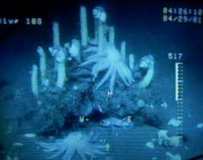 "Babysitter" snails on towers of spiral eggcases on a carbonate (microbially-precipitated) rock. 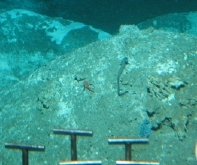 Hills of frozen hydrate, bacterial mats, and 3 species of fish [bars are tubecore handles on Alvin] 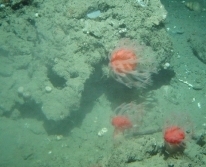 Mushroom corals on carbonate rocks |
OVERVIEW
Hydrothermal Vents: click here Our studies are on adaptation of seep and vent animals to high pressure and toxic sulfide. We have used specimens provided by Drs. C. Fisher (Penn State), R. Lee (WSU), L. Levin (Scripps Inst. Oceanography); 1995-96 specimens trawled up by me and Dr. Joe Siebenaller of L.S.U.; and 2006 specimens collected by me and colleagues on the Eel River seeps off California and Hydrate Ridge Seeps off Oregon in Alvin studies lead by Dr. Lisa Levin of Scripps Inst. Oceanography and Dr. Ray Lee of Washington State University. |
| ON THIS and the VENTS PAGE--our study sites: | |
|
1. MODERATE-DEPTH SEEPS --a. EEL RIVER SEEPS on the slope off Eureka, Calif., 510-520m, photographed and sampled by us using a remote-operated vehicle or ROV (2001), and with the ALVIN (2006) (studies led by Dr. Lisa Levin, Scripps Inst. Oceanography). --b. HYDRATE RIDGE SEEPS off Newport, Oregon, 599-890m, photographed and sampled on the ALVIN (2006), (studies led by Drs. Lisa Levin and Raymond Lee, Washington State Univ.).
| |
|
2. DEEP SEEPS: --a. OREGON SLOPE Seeps, 1800-2000 m, caught by deep-sea otter trawl (1995-96); with Dr. Joe Siebenaller of L.S.U. --b. Aleutian and Japan Trench Seeps, 4400-6400m; animals provided by Drs. Levin (Scripps) and C. Kato (JAMSTEC), respectively.
| |
| 3. HYDROTHERMAL VENTS--click here | |
|
MORE
ON SEEPS: see pictures below; and visit the
Penn.St.U.'s pages on Gulf-of-Mexico seeps and Monterey Bay Aquarium Research Institute's Cold-Seep site for more pictures and information. |
|
| 1a) EEL RIVER SEEPS - 2001 & 2006 **CLICK PICTURES FOR FULL VERSION**--The blue low-resolution images are from an ROV camera monitor; the other underwater scenes are from the ALVIN cameras. Pictures taken by me in air are samples brought back to the ship. Dr. Lisa Levin's site has more information and pictures of the Eel River study site |
 |
  |
 |
. . . . . |
|
| Methane vent. Click for 1.6MB QTmovie | Seep areas are littered with small to huge blocks of carbonate rocks, thought to be formed by precipitation from seep waters as a byproduct of microbial metabolism. The 3 rocks to the right were retrieved by the ROV; the rightmost one has an mushroom coral, Anthomastus ritteri, on it. See CNIDARIA page for more images. In the 9-Aug-2002 issue of Science (p.1013), Michaelis et al. discuss how microbes may play a role in forming carbonate rocks and reefs by this process: CH4 (methane) + SO4= + Ca++ --> CaCO3 (rock) + H2S +H2O | |||
|
2001 ROV video frames: Scenes of bacterial mats (white
patches), sometimes with clams. The bacterial are using sulfide and methane
gases for energy. The white strands may actually be animals (enteropneusts)
|
Calyptogena (or Vesycomya) spp, a clam
with bacterial symbionts in its gills. The foot protrudes
for taking up sulfide for the symbionts.--Right: ROV arm using tubecore
to collect the clams, mats, and sediment. The
Monterey Bay Aquarium deepsea site has a great picture of these clams
in their habitat. See also the DEEP SEEPS below.
|
Polychaete worms, living off bacteria? (60x magnification)
| ||

| 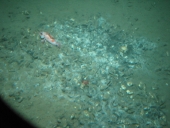
| 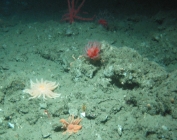
| 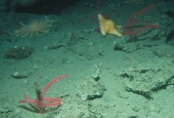
| 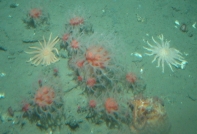 |
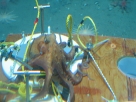
|
| Bacterial mat and vent hole (2006 Alvin photo) | Clambed with bacterial mat (2006 Alvin photo) | Mushroom coral, seapen, seastars on carbonate rocks (2006 Alvin photo), | Seastars, seapens on carbonate rocks (2006 Alvin photo) | Mushroom corals, seastars and OCTOUS near a seep (2006 Alvin photo) | An octopus climbs onto Alvin's box of colony trays and plays with the lids |
| 1b) HYDRATE RIDGE SEEPS - 2006. **CLICK PICTURES FOR FULL VERSION**--From the ALVIN cameras or my camera on the ship |
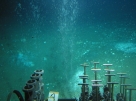 . . |
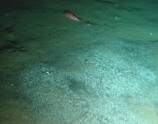 |
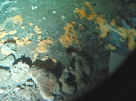 |
 |
 |
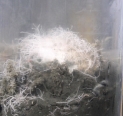 |
 |
|
| Methane vent at about 600m | White Beggiatoa bacterial mat at about 900m | Orange bacterial mat | Archaea or bacteria from the orange bacterial mat; see left | Another Beggiatoa white bacterial mat at about 600m | Rock with strands of white Beggiatoa bacteria in a lab bucket. They are actual colorless (click link for details) | Mysterious white ring in sediment at about 900m | |
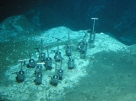 |
 . . |
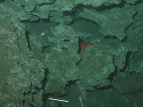 |
 |
 |
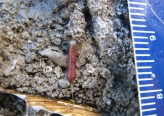 |
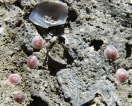 |
 |
|
Tubecores placed in Beggiatoa mat by
the Alvin pilot using the manipulator arm
| Tubecore #7 turns into a rocket as gas hydrate melts during Alvin's ascent and jets out the bottom of the tube | Carbonate rocks at 600m | Large carbonate rock (dubbed Big Mama by Dr. Levin) retrieved by Alvin | Vent rock retrieved from 880m, with crystalline chimney tunnels | Polychaete worm (a new species?) living in tube inside Big Mama (left). | Tiny limpets living on Big Mama rock (left) | Pilot Gavin uses Alvin's arm to retrieve a large shelly carbonate |
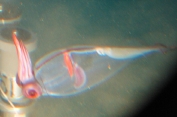 |
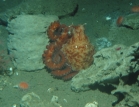 |
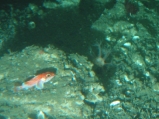 |
 |
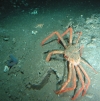 |
 |
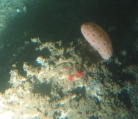 |
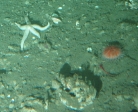 |
| Octopus and carbonate rocks at about 600m | Searobin, mushroom coral on carbonate rocks at 600m | Sea urchins dining on a dead Tanner crab (see crab, right) | Tanner crab, hagfish | Sponge on carbonate, 890m | Seastar, sea urchin at about 600 m |
| 2.
DEEP SEEPS Oregon--1800-2000m; Alaska--4400m; JAPAN--1100m, and Trench 6400m These are methane and sulfide seeps at various locations in the Pacific. The Oregon ones are on the continental shelf. The Alaska ones are in the Aleutian Trench. The Japan ones are in Sagami Bay and Okinawa Trough (about 1100m) and the Japan Trench. Click Here for SCHEMATIC DIAGRAM |
 |
 .. .. |
|
| Vestimentiferan
Seep Tubeworms From Oregon, Lamellibrachia barhami, a gutless vestimentiferan tubeworm with bacterial symbionts in its trophosome (an organ that replaces the gut). These symbionts use energy-rich gases to make useful organic compounds, excesses of which feed the worm host. We have discovered them to have high concentrations of methyltaurine, a highly unusual sulfur-based osmolyte (Yin et al., 2000). Lower right picture is the plume of a related escarpid worm; the plume absorbs molecules that the symbionts need. | Vesicomyid
Seep Clams LEFT: Vesicomya gigas (left) from Oregon seep, 1800-2000m (collected by us) MIDDLE: Calyptogena spp from Japan seep at 1050m (specimens provided by JAMSTEC) RIGHT: Calyptogena spp. from ALASKA at 4400 (specimens provided by Dr. Lisa Levin, Scripps) and JAPAN TRENCH at 6400m (Hadal zone) (specimens provided by JAMSTEC). Both clams have extremely elongated forms compared to other vesicomyid clams. To see the Alaska and Oregon clams in their habitats, see Dr. Lisa Levin's website. To see the Japan Trench clams in their habitat, click here for JAMSTEC's site--click on Photo Gallery then look for Cold Seep photo. These large clams have bacterial symbionts in their gills. The dissection photos show the gills, and the foot that this clam extends to gather sulfide (or methane?) for its symbionts. These symbionts use energy-rich gases to make useful organic compounds, excesses of which feed the clam host. |